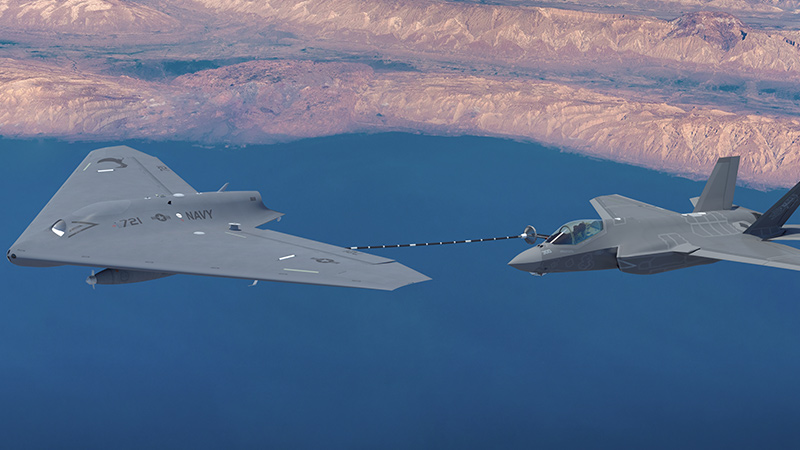Stay Up to Date
Submit your email address to receive the latest industry and Aerospace America news.
Former U.S. Deputy Secretary of Defense Robert O. Work explains his 2015 decision to go with a tanker aircraft rather than a stealthy, strike plane
It was late 2015, and U.S. defense planners were still going around and around about the future of unmanned naval aviation, as they had been for years.
Robert O. Work, at the time the U.S. deputy secretary of defense and a former undersecretary of the Navy, realized that the deliberations needed to be brought to a close. In coordination with the Navy, he made the decision to transform the service’s Unmanned Carrier Launched Airborne Surveillance and Strike, or UCLASS, program into an initiative to build a fleet of unmanned planes to deliver fuel to conventionally piloted planes, especially F/A-18s and the carrier variant of the stealth fighter, the F-35Cs.
I interviewed Work by phone at his office at the Center for a New American Security, the Washington, D.C., think tank where he now works.
He explained that his decision followed six years of debate inside the Pentagon and the Navy, with input from the Obama administration, about what form the Navy’s first carrier-based unmanned plane should take.
“There were three competing schools of thought,” he said.
One school advocated for a “very expensive” high-end, long-range strike aircraft capable of penetrating sophisticated defenses with a complimentary reconnaissance capability.
A second school wanted a less stealthy plane with even longer range to “prosecute the terrorism fight around the world” in pursuit of “high-value targets.” That was the view held by the Obama White House.
The third school wanted a plane that would offer more “situational awareness” around the carrier without being integrated into carrier operations with manned aircraft. According to Work, this was the Navy’s view.
With the arguments dragging on, Work stepped in.
“I said, ‘OK, what do we really need?’”
Members of the Joint Chiefs of Staff and Navy and Pentagon officials weighed in with the same answer: “stealth.”
“Then I asked: ‘If we started a program for a high-end stealthy unmanned penetrator that at least matched the F-35C in its stealth capabilities, how fast could we do that?”
Work said the officials responded that it would be slower than accelerating the F-35C buy.
So he decided to accelerate the buy of the F-35Cs and also explore Boeing’s proposed Advanced Super Hornet (now the Block 3 Super Hornet) whose conformal fuel tanks “would extend its range and allow it to operate with the F-35C.”
This way, “we would go with an unmanned system that we could afford,” Work said. Tankers “would be a lot less expensive” than a “high-end penetrator,” and they were “vitally needed to provide tanking for the air wing, freeing up the F/A-18s.”
As for the long term, by integrating unmanned aircraft into carrier air wing operations, “we would be able to move to an unmanned future when and if the time was right and the money was there.”
Work, who co-authored a 2007 report for the Center for Strategic and Budgetary Assessments in favor of unmanned combat aircraft, said he agrees that having a high-end unmanned plane capable of strike “would be good,” but “I’m still looking at the budgets. I don’t know how another program fits in.”
He’s also aware of his critics.
“Some said, ‘This is the wrong thing to do. We ought to have a high-end penetrator.’ To which I would say, ‘That would be great if we had any money to do so.’ They would say, ‘You ought to cancel the F-35C and have an unmanned system.’”
“I’d tell them, ‘The Navy has said they have to get stealth on deck as quickly as possible to be competitive. What is the fastest way to get stealth on deck? The answer is, the F-35C.’”
“We can afford this [the MQ-25]. We can get it out there relatively quickly and it will have an important campaign effect.”
Work does have one concern about MQ-25.
“I was surprised that the IOC [initial operating capability] has been announced as 2026. I would hope we can do better,” he said.
The Lockheed Martin illustration at the top of this page is an artist’s rendering of Lockheed Martin’s proposed version of the MQ-25 Stingray refueling a jet.
About Jan Tegler
Jan covers a variety of subjects, including defense, for publications internationally. He’s a frequent contributor to Defense Media Network/Faircount Media Group and is the author of the book “B-47 Stratojet: Boeing’s Brilliant Bomber,” as well as a general aviation pilot.
Related Posts
Stay Up to Date
Submit your email address to receive the latest industry and Aerospace America news.





